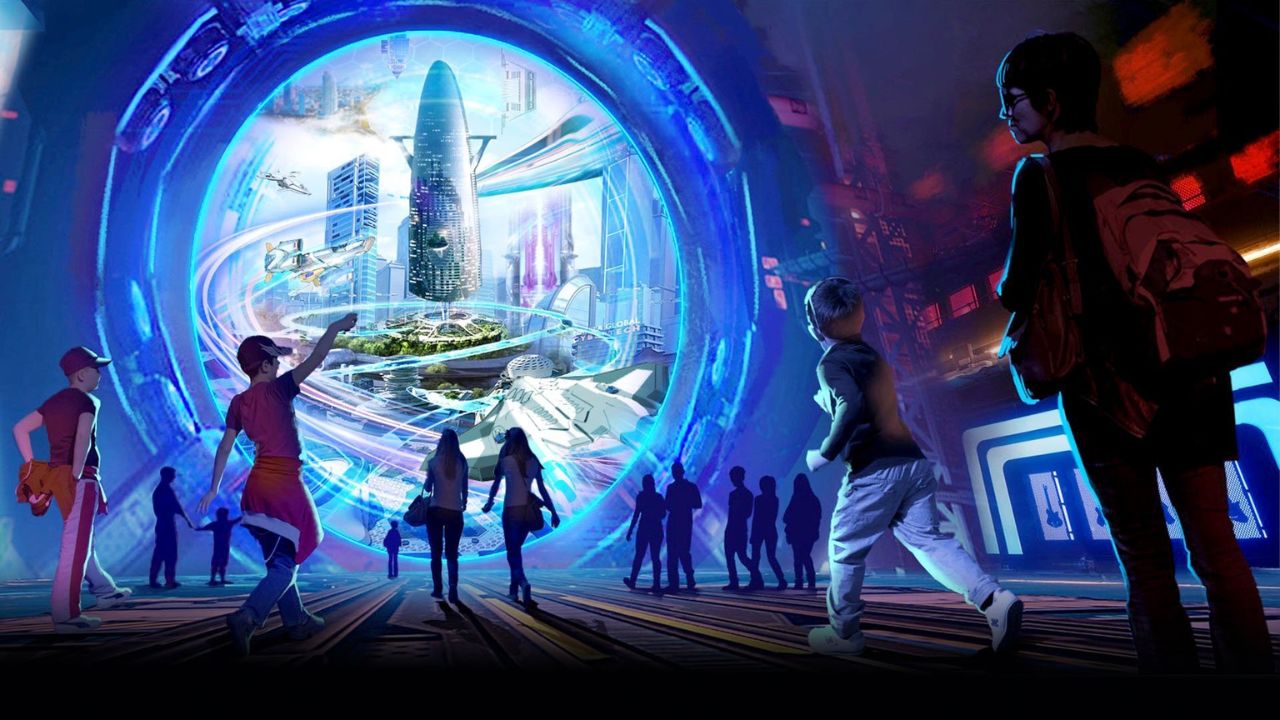Introduction
With the rapid advancement of technology, the concept of “Metaverse” has been gaining significant attention. It refers to a virtual reality space where people can interact with each other and computer-generated environments in a seemingly real-time and immersive experience. The Metaverse is often described as the convergence of physical and digital worlds, offering limitless possibilities for communication, collaboration, entertainment, and even commerce.
Though the term “Metaverse” was coined by science fiction writer Neal Stephenson in his novel Snow Crash, the idea of a virtual reality universe has been a long-standing dream for many visionaries and tech enthusiasts. It is a concept that has captured the imagination of both industry leaders and everyday individuals.
Over the years, several pioneers of virtual reality and technology have contributed to shaping the idea of the Metaverse. These visionaries have laid the groundwork for the development of this immersive digital realm. In this article, we will delve into the individuals who played a crucial role in the creation and popularization of the Metaverse.
By exploring their contributions, we can gain insights into the evolution and potential future of the Metaverse. From the early days of virtual reality to the current advancements in blockchain technology, the journey towards the creation of the Metaverse has been a collaborative effort driven by relentless innovation.
Let us now embark on a fascinating exploration of the individuals and organizations that have shaped and continue to shape the Metaverse as we know it today.
The Concept of Metaverse
The Metaverse is an expansive virtual reality space that allows users to interact with computer-generated environments and other users. It is a digital realm where people can simulate real-world experiences and explore limitless possibilities. In the Metaverse, users can socialize, work, play, and engage in various activities through their personalized avatars.
The concept of the Metaverse encompasses a seamless integration of physical and digital realities, creating an immersive and interactive environment. It goes beyond the traditional boundaries of virtual reality, as it aims to provide a shared space where people from around the world can come together and experience a collective virtual existence.
One of the key aspects of the Metaverse is its ability to offer persistent virtual worlds that evolve and grow over time. Unlike traditional online games or applications, the Metaverse is not confined to a single experience or a specific set of rules. It is a dynamic and ever-expanding universe that can be customized and shaped by its inhabitants.
The Metaverse also holds the potential for redefining how we interact with digital content. Instead of passively consuming information, users can actively participate in the creation and modification of the virtual world. This decentralized nature of the Metaverse allows for a collaborative and user-driven experience, where innovation and creativity can thrive.
Furthermore, the Metaverse has implications beyond just entertainment and social interactions. It has the potential to revolutionize various industries, such as education, healthcare, commerce, and more. The immersive nature of the Metaverse can enable new forms of learning, telemedicine, virtual shopping experiences, and even virtual workplaces.
However, the realization of the Metaverse is still a work in progress. It requires advancements in virtual reality technology, high-speed internet connectivity, and the integration of various emerging technologies like artificial intelligence, blockchain, and augmented reality. As these technologies continue to evolve, the boundaries of the Metaverse will continue to expand, unlocking new possibilities and experiences for its users.
In the following sections, we will explore the pioneers and organizations that have played a significant role in the creation and development of the Metaverse, shaping its trajectory and paving the way for its future.
The Pioneers of Virtual Reality
Virtual reality, the precursor to the concept of the Metaverse, has its roots in the 20th century. Many visionaries and innovators paved the way for the development of virtual reality technologies that eventually led to the emergence of the Metaverse.
One of the pioneers in this field is Ivan Sutherland, who is often referred to as the “Father of Computer Graphics.” In the 1960s, Sutherland developed the first virtual reality head-mounted display (HMD) called the “Sword of Damocles.” Although primitive by today’s standards, this early invention laid the foundation for immersive virtual reality experiences.
Another notable pioneer is Jaron Lanier, who coined the term “Virtual Reality” and founded VPL Research in the 1980s. Lanier’s company introduced innovative and immersive virtual reality systems, including the Data Glove and the EyePhone. These inventions were instrumental in shaping the future of virtual reality and creating a sense of presence and interactivity within virtual environments.
In the 1990s, a team of researchers led by Mark Bolas and Ian McDowall developed the “Cave Automatic Virtual Environment” (CAVE) at the University of Illinois at Chicago. The CAVE allowed users to project 3D virtual environments onto the walls of a room, creating a highly immersive experience. This breakthrough technology paved the way for the exploration of virtual reality beyond individual headsets.
Furthermore, the gaming industry played a significant role in popularizing virtual reality. Companies like Atari and Nintendo introduced early VR gaming devices, such as the Atari Jaguar VR and the Virtual Boy. Although these attempts were not commercially successful, they ignited public interest and laid the groundwork for future advancements.
The pioneers of virtual reality not only pushed the boundaries of technology but also explored the potential applications of virtual reality beyond gaming. They recognized the transformative power of virtual environments and strived to create immersive experiences that transcend physical limitations.
These early breakthroughs in virtual reality paved the way for the concept of the Metaverse. As technology continued to evolve, the dream of a fully immersive, interconnected, and shared digital reality began to take shape. The contributions of these pioneers laid the foundation for the emergence of the Metaverse and set the stage for subsequent advancements in the field.
In the next section, we will delve into the key developments that led to the realization of the Metaverse and the individuals who played a pivotal role in its creation.
The Emergence of The Metaverse
As technology evolved, the concept of the Metaverse began to take shape, driven by advancements in virtual reality, internet connectivity, and the increasing demand for immersive online experiences. The emergence of the Metaverse can be traced back to several key developments.
One of the significant milestones in the development of the Metaverse was the creation of Linden Lab’s “Second Life” in 2003. Second Life provided users with a virtual world where they could create custom avatars, build and monetize virtual properties, and interact with other users in a shared digital environment. It showcased the potential of a vast and interconnected virtual reality space where users could engage in various activities and experiences.
The success of Second Life sparked a broader interest in virtual reality and the concept of the Metaverse. It captured the attention of both individuals and companies, laying the groundwork for future innovations in the field.
In 2014, Facebook made a significant move towards the Metaverse by acquiring the virtual reality startup Oculus VR. With this acquisition, Mark Zuckerberg expressed his vision of building a connected virtual reality platform that goes beyond gaming. Facebook’s involvement in the development of the Metaverse brought the concept further into the mainstream consciousness and demonstrated the potential for social interaction and collaboration within virtual environments.
Another influential development in the Metaverse’s emergence was the advent of blockchain technology and the rise of cryptocurrencies. Blockchain’s decentralized nature and its ability to create digital scarcity have opened up new opportunities for implementing virtual assets and economies within the Metaverse. This has led to the emergence of decentralized Metaverse projects, such as Decentraland and Somnium Space, which utilize blockchain technology to establish virtual property ownership, digital art marketplaces, and peer-to-peer transactions.
Moreover, in recent years, the concept of the Metaverse has gained significant attention from thought leaders and innovators in the tech world. The Open Metaverse Foundation, founded in 2020, aims to establish an open, standards-based Metaverse that fosters interoperability and collaboration between various virtual worlds and platforms. By bringing together stakeholders from different domains, the foundation seeks to ensure a decentralized and inclusive approach to the development of the Metaverse.
Overall, the emergence of the Metaverse can be attributed to the convergence of various technological advancements and the collective imagination of visionaries and pioneers in the field of virtual reality. As the development of the Metaverse continues to progress, it holds immense potential to reshape how we interact, work, and socialize in the digital realm.
Next, we will explore the contributions of key individuals, such as Philip Rosedale and Mark Zuckerberg, who have played a pivotal role in shaping and advancing the Metaverse concept.
Philip Rosedale: Founder of Second Life
Philip Rosedale is a prominent figure in the development of the Metaverse, most notably known as the founder of Second Life. Rosedale’s vision and entrepreneurial spirit contributed significantly to the realization of a shared, immersive virtual world.
In 2003, Rosedale founded Linden Lab, the company behind Second Life. The platform allowed users to create their own virtual identities in the form of avatars, engage with others in real-time, and build and monetize virtual properties. Second Life gained immense popularity and became a pioneer in the field of virtual worlds.
Rosedale’s vision for Second Life was not limited to creating a game but rather aiming for a virtual reality space where users could live, work, and play. He wanted to create an open-ended platform that empowered its users to shape their virtual experiences and define the rules of the virtual world.
Second Life became a prime example of the potential of the Metaverse, showcasing the vivid imagination and creativity of its user community. The platform witnessed the rise of virtual businesses, art exhibitions, educational institutions, and even political campaigns within its digital realm.
Rosedale’s leadership and innovative approach in designing the infrastructure for Second Life laid the foundation for future developments in the Metaverse. He emphasized the importance of user-generated content and encouraged the community to take an active role in shaping the virtual world.
Although Second Life faced challenges and criticisms over the years, including issues of scalability and virtual property rights, it played a crucial role in popularizing the concept of the Metaverse and demonstrating the possibility of a vast, user-driven virtual reality world.
Philip Rosedale’s contributions to the development of the Metaverse extend beyond Second Life. After leaving Linden Lab in 2008, Rosedale continued to explore immersive virtual reality experiences with his new venture, High Fidelity. High Fidelity utilized virtual reality technology to create a shared virtual reality space where users could interact with each other using their avatars in real-time.
Rosedale’s endeavors have been instrumental in pushing the boundaries of virtual reality and advancing the concept of the Metaverse. His passion for creating immersive digital environments has inspired countless individuals and organizations to explore the possibilities of a fully interconnected and interactive virtual reality space.
By fostering user empowerment, embracing innovation, and encouraging collaboration, Philip Rosedale’s contributions have left an indelible mark on the evolution and ongoing development of the Metaverse.
In the next section, we will explore the involvement of Mark Zuckerberg and Facebook in the development of the Metaverse.
Mark Zuckerberg and Facebook’s Involvement
Mark Zuckerberg, the co-founder and CEO of Facebook, has been actively involved in the development of the Metaverse. Recognizing the potential of virtual reality and the transformative power it holds, Zuckerberg has expressed his vision of building a connected, immersive virtual reality platform.
In 2014, Facebook made headlines with its acquisition of Oculus VR, a leading virtual reality hardware and software company. This move demonstrated Facebook’s commitment to exploring the possibilities of virtual reality and its ambition to play a significant role in the future of the Metaverse.
Under Zuckerberg’s leadership, Facebook has been investing resources and expertise in the development of virtual reality technologies. The company released the Oculus Rift, a high-end virtual reality headset, and the Oculus Quest, a standalone and more accessible VR device.
Facebook’s involvement in the Metaverse goes beyond gaming and entertainment. Zuckerberg envisions a future where people can use virtual reality to connect, collaborate, and experience immersive digital environments together. He sees the Metaverse as a new platform for social interaction, communication, and productivity.
As part of Facebook’s commitment to the Metaverse, the company introduced Horizon Workrooms, a virtual reality meeting platform that aims to redefine the way people collaborate remotely. This platform enables users to have virtual meetings, brainstorm ideas, and work together in a shared virtual space using their personalized avatars.
Furthermore, Facebook has been actively exploring the integration of augmented reality into its platforms, including Facebook and Instagram. Through initiatives like Facebook’s Project Aria, which focuses on the development of wearable AR devices, Zuckerberg aims to bring augmented reality closer to everyday life and create a seamless integration between the physical and digital worlds.
Zuckerberg believes in the potential of the Metaverse to democratize access and enable people from diverse backgrounds to connect and create together. He envisions a future where the Metaverse becomes an integral part of our daily lives, enabling us to transcend the limitations of physical proximity and enhance our interactions in meaningful ways.
As one of the most influential figures in the tech industry, Zuckerberg’s involvement in the Metaverse underscores the importance and potential impact of this emerging technology. Facebook’s resources, user base, and commitment to innovation position the company as a key player in shaping the future of the Metaverse.
In the next section, we will explore the influence of crypto and blockchain technology on the creation and development of the Metaverse.
Decentralized Metaverse: Crypto and Blockchain Influence
The emergence of cryptocurrencies and blockchain technology has had a significant influence on the development of the Metaverse, leading to the rise of decentralized virtual worlds and economies. The decentralized nature of blockchain technology has provided new opportunities for creating and governing virtual reality spaces, enabling users to have true ownership and control over their digital assets.
One of the notable projects in the decentralized Metaverse space is Decentraland. Built on the Ethereum blockchain, Decentraland allows users to buy, sell, and trade virtual land and digital assets using the platform’s native cryptocurrency, MANA. This decentralized approach to virtual property ownership empowers users and enables them to create and monetize virtual experiences within the Metaverse.
Blockchains also enable the creation and management of Non-Fungible Tokens (NFTs), which have become increasingly popular in the art and virtual asset markets. NFTs provide a way to authenticate and trade unique digital items, such as virtual art, in-game assets, and virtual real estate. These virtual assets can be seamlessly integrated into decentralized Metaverse platforms, establishing digital scarcity and enabling users to create value within these virtual worlds.
Blockchain’s transparent and immutable nature also addresses concerns related to security, trust, and provenance within the Metaverse. By leveraging blockchain technology, virtual transactions can be securely recorded, and the history of ownership can be easily verified. This increases transparency and reduces the chances of fraud or counterfeit virtual assets, creating a more reliable and trustworthy environment for users.
Furthermore, blockchain technology enables interoperability between different decentralized Metaverse platforms. This means that virtual assets and experiences created in one platform can potentially be used or transferred to another, fostering an interconnected virtual reality ecosystem. This interoperability allows for the seamless movement of avatars, goods, and virtual currencies across various Metaverse environments, providing users with greater flexibility and freedom.
As the demand for decentralized Metaverse experiences continues to grow, blockchain technology and cryptocurrencies are likely to play an increasingly significant role. Integrating blockchain technology into the Metaverse not only enhances user experiences but also enables novel forms of collaboration, content creation, and economic opportunities.
Blockchain’s influence on the Metaverse extends beyond the technical aspects. It embodies a philosophy of decentralization, democratization, and user empowerment, aligning with the core values of the Metaverse. This decentralized approach to the Metaverse has the potential to reshape industries, foster new business models, and revolutionize how people interact and create within virtual reality spaces.
In the next section, we will explore the efforts of the Open Metaverse Foundation in establishing an open and inclusive approach to the development of the Metaverse.
The Open Metaverse Foundation
The Open Metaverse Foundation is an organization dedicated to promoting an open and inclusive approach to the development of the Metaverse. Founded in 2020, the foundation aims to foster collaboration, interoperability, and standards within the Metaverse ecosystem, ensuring that the virtual reality space is accessible and equitable for all.
The Open Metaverse Foundation recognizes the importance of establishing interoperability among different virtual worlds and platforms. By defining and advocating for open standards, protocols, and APIs, the foundation encourages seamless communication and interaction between various Metaverse environments. This interoperability allows users to traverse different virtual worlds and retain their avatars, assets, and social connections.
One of the key initiatives of the Open Metaverse Foundation is to ensure decentralization and user empowerment within the Metaverse. By exploring the use of blockchain and other distributed technologies, the foundation aims to create an environment where individuals have full ownership and control over their virtual assets and identities. This shift away from centralized control promotes user privacy, data security, and a sense of ownership within the virtual reality space.
Additionally, the Open Metaverse Foundation emphasizes the importance of inclusivity and diversity within the Metaverse. They aim to actively involve communities, artists, developers, and stakeholders from a wide range of backgrounds to contribute to the development and design of the Metaverse. By fostering an inclusive environment, the foundation seeks to address potential biases and ensure that the Metaverse reflects the diverse perspectives and experiences of its users.
The foundation also highlights the importance of education and research in the Metaverse field. They support and collaborate with academic institutions, researchers, and developers to advance the understanding and development of virtual reality technologies. By fostering a robust research community, the foundation aims to drive innovation and explore the potential applications of the Metaverse in various industries and sectors.
Through its efforts, the Open Metaverse Foundation plays a crucial role in shaping the future direction of the Metaverse. By advocating for openness, decentralization, interoperability, and inclusivity, the foundation strives to create an environment where the Metaverse can thrive as a collaborative and user-driven virtual reality space.
As the technology and adoption of the Metaverse continue to evolve, the initiatives and vision of the Open Metaverse Foundation will be instrumental in ensuring that the Metaverse remains a space that benefits and empowers all individuals.
In the next section, we will explore other notable contributors to the creation and development of the Metaverse.
Other Notable Contributors to Metaverse Creation
While pioneers like Philip Rosedale and Mark Zuckerberg have made significant contributions to the creation and development of the Metaverse, there are several other notable individuals and organizations that have played a critical role in shaping this emerging virtual reality space.
Tim Sweeney, the founder of Epic Games, has been instrumental in driving the advancement of virtual reality and the Metaverse. Through Epic Games’ Unreal Engine, developers have gained access to powerful tools and resources for building immersive virtual worlds. Sweeney’s vision of the Metaverse aligns with a belief in a future where virtual reality is a seamless part of everyday life, offering limitless possibilities for entertainment, education, and beyond.
Roblox Corporation, led by David Baszucki, has made a significant impact in creating a user-generated Metaverse for gaming and social experiences. Roblox allows users to create their virtual worlds and games, fostering a vibrant and diverse community-driven environment. With millions of active users and a robust development platform, Roblox has become a popular destination for those seeking engaging virtual experiences within the Metaverse.
The team at NVIDIA, led by Jensen Huang, has played a crucial role in advancing virtual reality technology by developing powerful graphics processing units (GPUs). These GPUs are vital in rendering immersive and realistic virtual environments, enabling users to experience the Metaverse with high visual fidelity and smooth performance. NVIDIA’s dedication to pushing the boundaries of graphics technology has made a significant impact on the overall development of the virtual reality industry.
Non-profit organizations such as the Virtual Reality Society (VRS) and the Virtual World Society (VWS) have also contributed to the creation and awareness of the Metaverse. These organizations focus on education, research, and advocacy, promoting the positive impact of virtual reality and the Metaverse on various industries, including healthcare, education, and entertainment. They provide a platform for collaboration and information sharing, fostering a community that is passionate about advancing the potential of the Metaverse.
Additionally, virtual reality hardware manufacturers like HTC, Sony, and Valve have played a vital role in popularizing virtual reality and the Metaverse by developing advanced headsets and controllers. Their commitment to improving the hardware and user experience has paved the way for more accessible and immersive virtual reality experiences.
Collectively, these notable contributors have helped shape the Metaverse from various angles, whether through technological advancements, user-driven content creation, or advocacy. Their efforts and innovations continue to drive the evolution of the Metaverse, expanding its potential and opening new doorways for experiences and collaborations.
In the concluding section, we will summarize the key insights gained from exploring the creation and development of the Metaverse and discuss its future prospects.
Conclusion
The Metaverse, a virtual reality space where people can interact with computer-generated environments and each other, represents a transformative concept that has evolved over time. The pioneers of virtual reality, such as Ivan Sutherland and Jaron Lanier, laid the foundation for immersive digital experiences. Innovators like Philip Rosedale and Mark Zuckerberg further propelled the development of the Metaverse through platforms like Second Life and Facebook’s foray into virtual reality.
The Metaverse has been shaped by various technological advancements, including the rise of blockchain and cryptocurrencies. Decentralized Metaverse projects, such as Decentraland, have leveraged blockchain technology to enable true ownership and trading of virtual assets, while promoting user empowerment and the creation of virtual economies.
The Open Metaverse Foundation has championed openness, interoperability, and inclusivity within the Metaverse. By advocating for standards and collaboration, the foundation aims to establish a decentralized and user-centric virtual reality space.
Other notable contributors, like Tim Sweeney of Epic Games and the team at NVIDIA, have driven technological advancements that have enhanced the immersive capabilities of the Metaverse. Companies like Roblox Corporation have fostered user-generated content and vibrant communities, redefining the concept of virtual worlds.
As we look to the future, the Metaverse holds tremendous potential to revolutionize industries, redefine social interactions, and reshape how we experience the digital realm. It has the power to transform education, healthcare, commerce, and entertainment, providing new ways to collaborate, learn, and create.
However, challenges such as technical limitations, privacy concerns, and the need for universal accessibility remain. The development of the Metaverse requires continued innovation, collaboration, and a commitment to ensuring inclusivity and user empowerment.
While the journey towards fully realizing the Metaverse is ongoing, the strides made by visionaries, pioneers, and organizations have paved the way for a future where the boundaries between physical and digital realities blur. The Metaverse represents a remarkable convergence of technology, creativity, and human imagination, offering unlimited possibilities for the way we interact, create, and experience the world.
As we move forward, it is crucial to foster a collective vision for the Metaverse that promotes openness, innovation, and positive impact. By embracing collaboration and inclusivity, we can shape the Metaverse into a space that empowers individuals, facilitates meaningful connections, and augments our human experiences in ways that were once unimaginable.

























